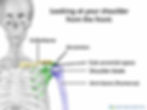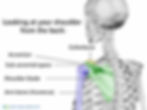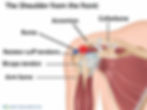Shoulder impingement – A common cause of shoulder pain
- Maryke Louw
- Aug 12, 2018
- 4 min read
Updated: Jan 27, 2023
One of the most common types of shoulder pain that I treat in clinic is sub-acromial impingement. I know, it’s a mouthful! But the name will make a lot of sense once I’ve explained how the shoulder joint works and what the cause of this type of shoulder pain is. I’ve also included some exercises that I use for shoulder impingement.

Some of the links in this article are to pages where you can buy products or brands discussed or mentioned here. We earn a small commission on the sale of these products at no extra cost to you.
In this article:
A quick lesson in shoulder anatomy
How do you know if you have shoulder impingement?
The most common causes of shoulder impingement
How to treat shoulder impingement
Exercises for shoulder impingement
A quick lesson in shoulder anatomy
Your shoulder joint is formed by three bones. The collarbone and the tip of the shoulder blade (acromion) forms the roof of the shoulder joint – that’s the hard bone you can touch on top of your shoulder. The head of your arm bone (humerus) sits comfortably in the cavity they form.
The space between the roof (collarbone + acromion) and the head of the humerus is called the sub-acromial space. This space is home to several tendons including the tendons of your rotator cuff and bicep muscles. It also has a bursa which is a little fluid filled sac that is meant to reduce the friction between the bones and the tendons.
As you move your arm up, the shoulder blade has to tilt backwards to prevent the bones from hitting each other and squashing the tendons and bursa. If for some reason (I discuss these below) the shoulder blade does not get out of the way of the arm bone and you repeat this movement several times, this compression eventually causes inflammation in either the tendons or the bursa or both, resulting in shoulder impingement.


How do you know if you have shoulder impingement?
Shoulder impingement is usually caused by an activity that involves repetitive arm movements e.g. swimming, doing overhead weights, cutting hedges, painting a wall, cleaning etc.
You often don’t feel any pain while you’re doing the activity but only develop the pain a few hours later or wake up with a painful shoulder the next morning. It’s important to distinguish between a muscle tear and impingement. You’ve likely torn a muscle if you’ve felt a sudden sharp pain while doing an exercise or while working.I
t’s painful to reach above shoulder height or to put your arm behind you.
It's normal for the pain to refer into your upper arm and down to your elbow.

The most common causes of shoulder impingement
There are several reasons why your shoulder blade may be slow to move out of the way of the humerus and cause shoulder impingement. The top causes I see in practice are:
1. Rounded shoulders
Rounded shoulders are caused by the shoulder blades sitting in a protracted and forward tilted position. Remember that we need the shoulder blades to tilt backward to get out of the way of the humerus when the arm moves? Protracted shoulder blades cause the sub-acromial space to narrow and is one of the main causes for shoulder impingement.
People end up with rounded shoulders for several reasons:
They may have generally poor posture and slouch. Try this: Slouch your spine and stick your chin out. Notice what happens to your shoulders – they drop forward. Now sit up nice and straight – try and push the ceiling away with the top of your skull. Notice how your shoulders immediately fall into a better position. Over time your spine and shoulders will get stiff in this slouched position and your postural muscle will become weak (because you’re not using them!). You can turn this around by doing specific exercises, but the longer you wait the harder it will be.
If you exercise the front of your chest (especially your pec muscles) a lot and don’t stretch it out to maintain your flexibility, your pecs will become tight and pull your shoulders forward.
2. When you do an activity that you’re not used to
You may have fair posture, but if you do an activity that you’re not used to or do too much of the same activity your muscles around your shoulder blades may get tired and allow your shoulder blades to tilt forward.
For example if you do too many hard swimming sessions without allowing enough recovery time or if you spend 3 hours cutting hedges in the garden.
How to treat shoulder impingement
Step 1: Get it diagnosed to make sure it’s not a muscles tear – the two conditions can feel very similar.
Step 2: Correct your posture and retrain your shoulder blades to sit in a more retracted position. I show you how to do this in the video below.
Step 3: Teach your shoulder blades to stay out of the way as you move your arms and strengthen the muscles that are meant to stabilise your shoulder blades.
Exercises for shoulder impingement
You should always work on improving your posture and teaching yourself how to move your shoulder blade before you do and strengthening exercises.
In the video below, I show you how to correct your spinal posture and set your shoulder blades. I also demonstrate 2 of my favourite exercises for shoulder impingement. These may not be appropriate for you so please consult a medical professional before you try them.
Need more help with your injury? You’re welcome to consult one of the team at SIP online via video call for an assessment of your injury and a tailored treatment plan.

About the Author
Maryke Louw is a chartered physiotherapist with more than 15 years' experience and a Masters Degree in Sports Injury Management. Follow her on LinkedIn or ResearchGate.
References:
Brukner, P, et al. Brukner & Khan's Clinical Sports Medicine. Vol 1: Injuries. (2017) McGraw-Hill Education. (Links to Amazon)
